Developing a Personal Classroom Management Philosophy Essay
VerifiedAdded on 2023/06/11
|16
|4211
|423
Essay
AI Summary
This essay presents a personal philosophy of classroom management, emphasizing the importance of creating a positive and productive learning environment. It discusses effective communication, building positive teacher-student relationships, and understanding student behavior through theories like Dreikurs' Goal-Centered theory. The philosophy advocates for a democratic teaching style, mutual respect, and focusing on students' strengths. It also highlights the role of professional reflexivity and continuous improvement in teaching practices. The essay concludes by stressing the need for adaptable curriculum planning to cater to diverse student needs, referencing various academic sources to support its arguments. Desklib offers a wealth of similar resources for students seeking to enhance their understanding of classroom management.
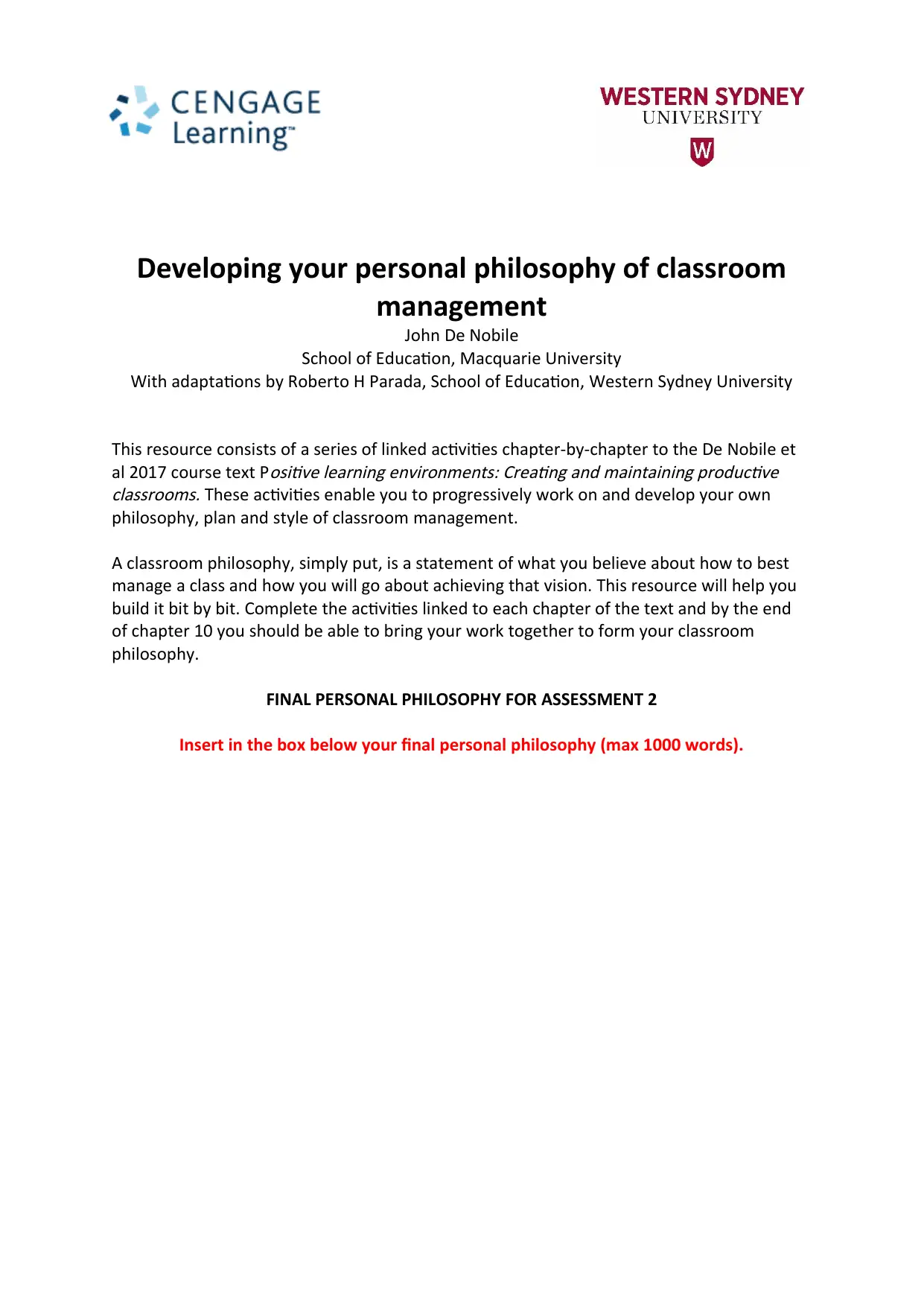
Developing your personal philosophy of classroom
management
John De Nobile
School of Education, Macquarie University
With adaptations by Roberto H Parada, School of Education, Western Sydney University
This resource consists of a series of linked activities chapter-by-chapter to the De Nobile et
al 2017 course text P
ositive learning environments: Creating and maintaining productive
classrooms. These activities enable you to progressively work on and develop your own
philosophy, plan and style of classroom management.
A classroom philosophy, simply put, is a statement of what you believe about how to best
manage a class and how you will go about achieving that vision. This resource will help you
build it bit by bit. Complete the activities linked to each chapter of the text and by the end
of chapter 10 you should be able to bring your work together to form your classroom
philosophy.
FINAL PERSONAL PHILOSOPHY FOR ASSESSMENT 2
Insert in the box below your final personal philosophy (max 1000 words).
management
John De Nobile
School of Education, Macquarie University
With adaptations by Roberto H Parada, School of Education, Western Sydney University
This resource consists of a series of linked activities chapter-by-chapter to the De Nobile et
al 2017 course text P
ositive learning environments: Creating and maintaining productive
classrooms. These activities enable you to progressively work on and develop your own
philosophy, plan and style of classroom management.
A classroom philosophy, simply put, is a statement of what you believe about how to best
manage a class and how you will go about achieving that vision. This resource will help you
build it bit by bit. Complete the activities linked to each chapter of the text and by the end
of chapter 10 you should be able to bring your work together to form your classroom
philosophy.
FINAL PERSONAL PHILOSOPHY FOR ASSESSMENT 2
Insert in the box below your final personal philosophy (max 1000 words).
Paraphrase This Document
Need a fresh take? Get an instant paraphrase of this document with our AI Paraphraser
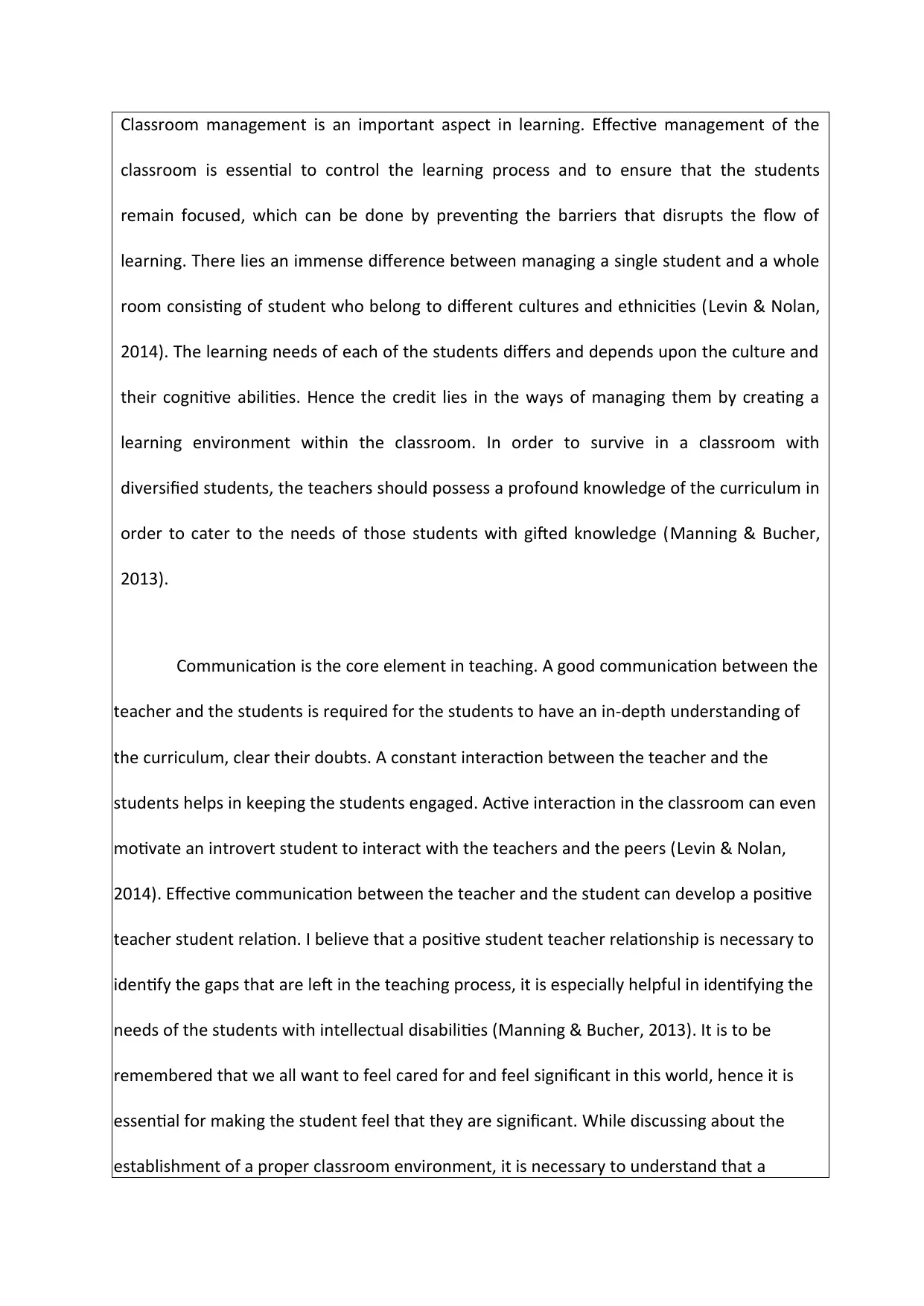
Classroom management is an important aspect in learning. Effective management of the
classroom is essential to control the learning process and to ensure that the students
remain focused, which can be done by preventing the barriers that disrupts the flow of
learning. There lies an immense difference between managing a single student and a whole
room consisting of student who belong to different cultures and ethnicities (Levin & Nolan,
2014). The learning needs of each of the students differs and depends upon the culture and
their cognitive abilities. Hence the credit lies in the ways of managing them by creating a
learning environment within the classroom. In order to survive in a classroom with
diversified students, the teachers should possess a profound knowledge of the curriculum in
order to cater to the needs of those students with gifted knowledge (Manning & Bucher,
2013).
Communication is the core element in teaching. A good communication between the
teacher and the students is required for the students to have an in-depth understanding of
the curriculum, clear their doubts. A constant interaction between the teacher and the
students helps in keeping the students engaged. Active interaction in the classroom can even
motivate an introvert student to interact with the teachers and the peers (Levin & Nolan,
2014). Effective communication between the teacher and the student can develop a positive
teacher student relation. I believe that a positive student teacher relationship is necessary to
identify the gaps that are left in the teaching process, it is especially helpful in identifying the
needs of the students with intellectual disabilities (Manning & Bucher, 2013). It is to be
remembered that we all want to feel cared for and feel significant in this world, hence it is
essential for making the student feel that they are significant. While discussing about the
establishment of a proper classroom environment, it is necessary to understand that a
classroom is essential to control the learning process and to ensure that the students
remain focused, which can be done by preventing the barriers that disrupts the flow of
learning. There lies an immense difference between managing a single student and a whole
room consisting of student who belong to different cultures and ethnicities (Levin & Nolan,
2014). The learning needs of each of the students differs and depends upon the culture and
their cognitive abilities. Hence the credit lies in the ways of managing them by creating a
learning environment within the classroom. In order to survive in a classroom with
diversified students, the teachers should possess a profound knowledge of the curriculum in
order to cater to the needs of those students with gifted knowledge (Manning & Bucher,
2013).
Communication is the core element in teaching. A good communication between the
teacher and the students is required for the students to have an in-depth understanding of
the curriculum, clear their doubts. A constant interaction between the teacher and the
students helps in keeping the students engaged. Active interaction in the classroom can even
motivate an introvert student to interact with the teachers and the peers (Levin & Nolan,
2014). Effective communication between the teacher and the student can develop a positive
teacher student relation. I believe that a positive student teacher relationship is necessary to
identify the gaps that are left in the teaching process, it is especially helpful in identifying the
needs of the students with intellectual disabilities (Manning & Bucher, 2013). It is to be
remembered that we all want to feel cared for and feel significant in this world, hence it is
essential for making the student feel that they are significant. While discussing about the
establishment of a proper classroom environment, it is necessary to understand that a
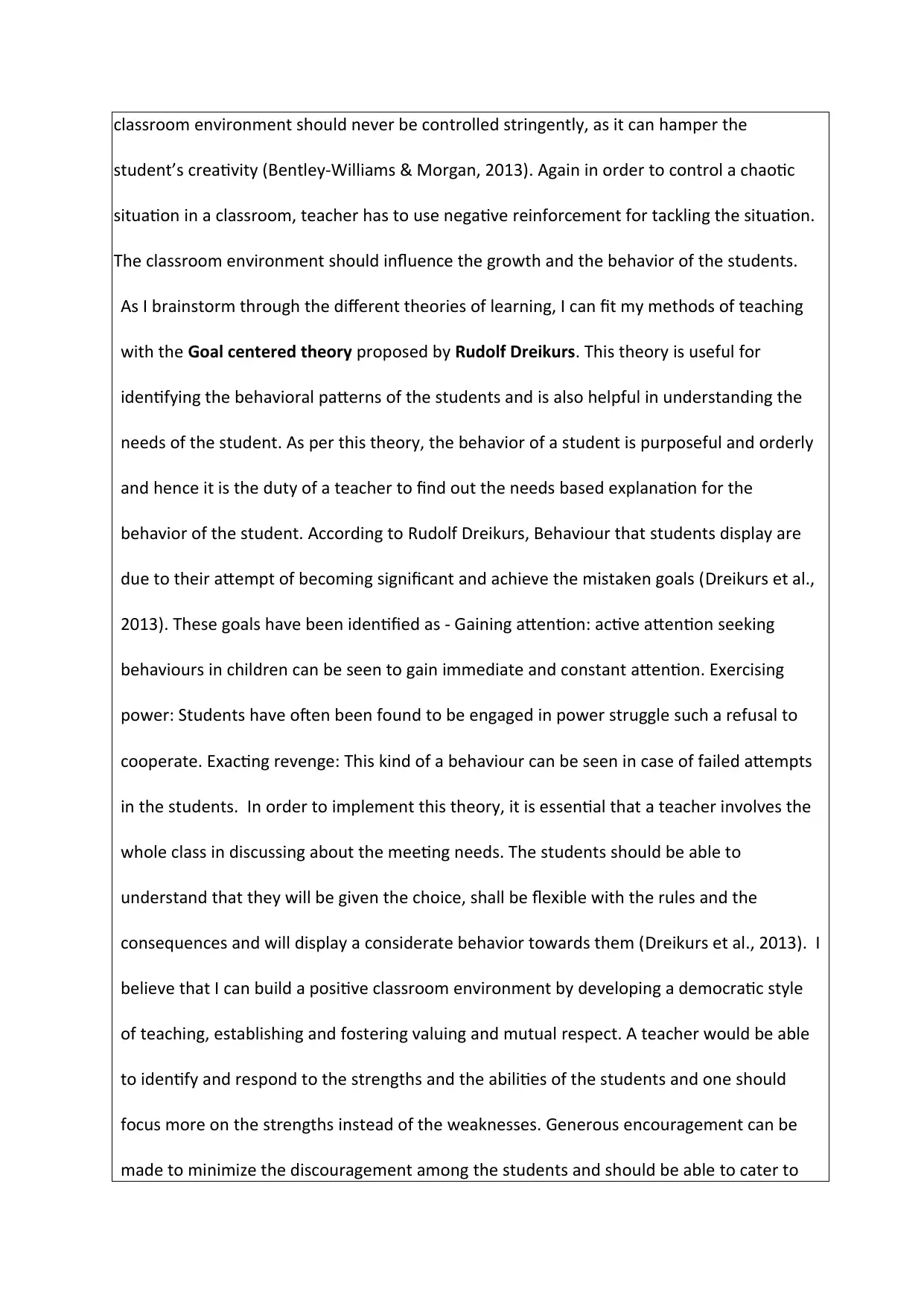
classroom environment should never be controlled stringently, as it can hamper the
student’s creativity (Bentley-Williams & Morgan, 2013). Again in order to control a chaotic
situation in a classroom, teacher has to use negative reinforcement for tackling the situation.
The classroom environment should influence the growth and the behavior of the students.
As I brainstorm through the different theories of learning, I can fit my methods of teaching
with the Goal centered theory proposed by Rudolf Dreikurs. This theory is useful for
identifying the behavioral patterns of the students and is also helpful in understanding the
needs of the student. As per this theory, the behavior of a student is purposeful and orderly
and hence it is the duty of a teacher to find out the needs based explanation for the
behavior of the student. According to Rudolf Dreikurs, Behaviour that students display are
due to their attempt of becoming significant and achieve the mistaken goals (Dreikurs et al.,
2013). These goals have been identified as - Gaining attention: active attention seeking
behaviours in children can be seen to gain immediate and constant attention. Exercising
power: Students have often been found to be engaged in power struggle such a refusal to
cooperate. Exacting revenge: This kind of a behaviour can be seen in case of failed attempts
in the students. In order to implement this theory, it is essential that a teacher involves the
whole class in discussing about the meeting needs. The students should be able to
understand that they will be given the choice, shall be flexible with the rules and the
consequences and will display a considerate behavior towards them (Dreikurs et al., 2013). I
believe that I can build a positive classroom environment by developing a democratic style
of teaching, establishing and fostering valuing and mutual respect. A teacher would be able
to identify and respond to the strengths and the abilities of the students and one should
focus more on the strengths instead of the weaknesses. Generous encouragement can be
made to minimize the discouragement among the students and should be able to cater to
student’s creativity (Bentley-Williams & Morgan, 2013). Again in order to control a chaotic
situation in a classroom, teacher has to use negative reinforcement for tackling the situation.
The classroom environment should influence the growth and the behavior of the students.
As I brainstorm through the different theories of learning, I can fit my methods of teaching
with the Goal centered theory proposed by Rudolf Dreikurs. This theory is useful for
identifying the behavioral patterns of the students and is also helpful in understanding the
needs of the student. As per this theory, the behavior of a student is purposeful and orderly
and hence it is the duty of a teacher to find out the needs based explanation for the
behavior of the student. According to Rudolf Dreikurs, Behaviour that students display are
due to their attempt of becoming significant and achieve the mistaken goals (Dreikurs et al.,
2013). These goals have been identified as - Gaining attention: active attention seeking
behaviours in children can be seen to gain immediate and constant attention. Exercising
power: Students have often been found to be engaged in power struggle such a refusal to
cooperate. Exacting revenge: This kind of a behaviour can be seen in case of failed attempts
in the students. In order to implement this theory, it is essential that a teacher involves the
whole class in discussing about the meeting needs. The students should be able to
understand that they will be given the choice, shall be flexible with the rules and the
consequences and will display a considerate behavior towards them (Dreikurs et al., 2013). I
believe that I can build a positive classroom environment by developing a democratic style
of teaching, establishing and fostering valuing and mutual respect. A teacher would be able
to identify and respond to the strengths and the abilities of the students and one should
focus more on the strengths instead of the weaknesses. Generous encouragement can be
made to minimize the discouragement among the students and should be able to cater to
⊘ This is a preview!⊘
Do you want full access?
Subscribe today to unlock all pages.

Trusted by 1+ million students worldwide
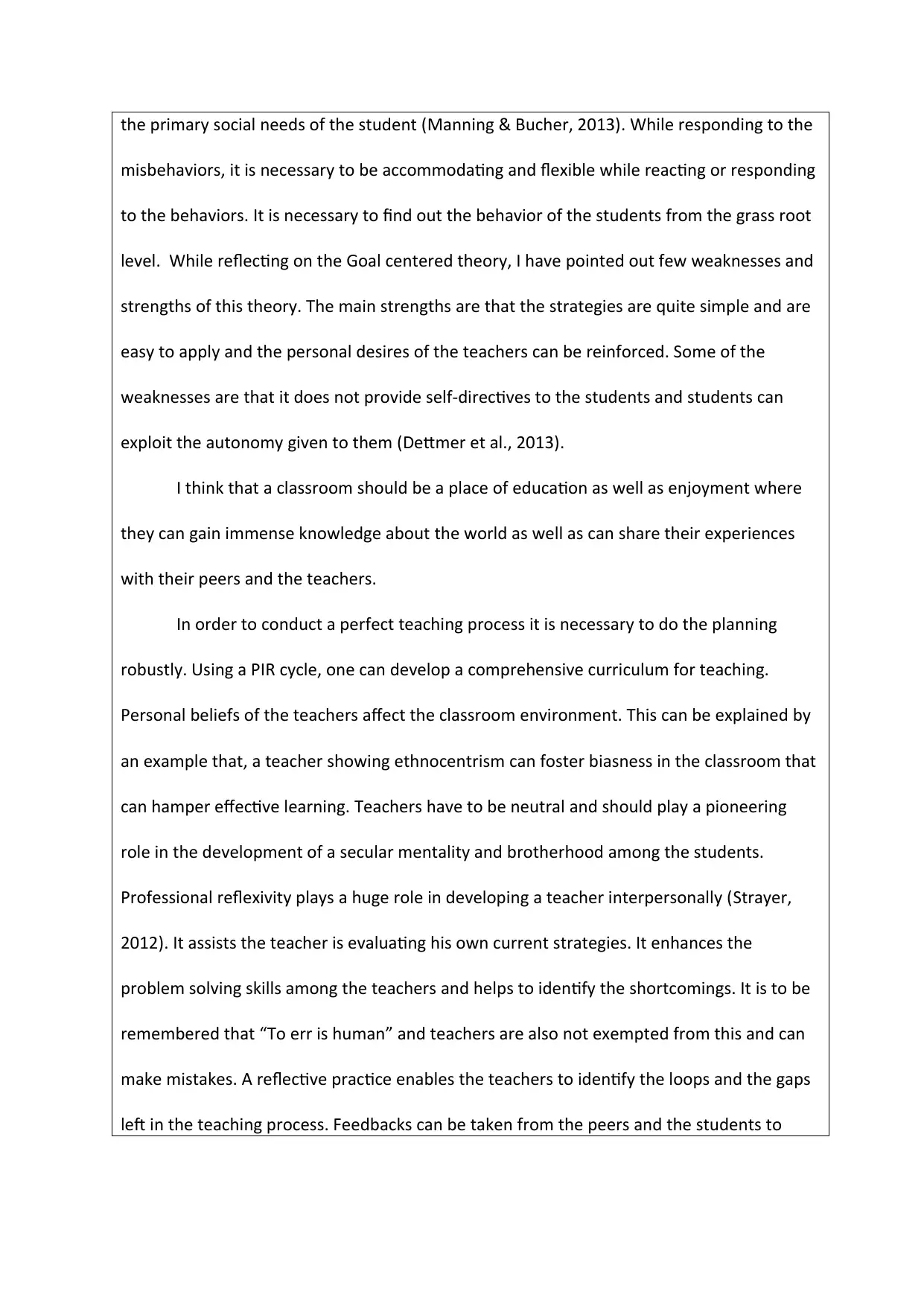
the primary social needs of the student (Manning & Bucher, 2013). While responding to the
misbehaviors, it is necessary to be accommodating and flexible while reacting or responding
to the behaviors. It is necessary to find out the behavior of the students from the grass root
level. While reflecting on the Goal centered theory, I have pointed out few weaknesses and
strengths of this theory. The main strengths are that the strategies are quite simple and are
easy to apply and the personal desires of the teachers can be reinforced. Some of the
weaknesses are that it does not provide self-directives to the students and students can
exploit the autonomy given to them (Dettmer et al., 2013).
I think that a classroom should be a place of education as well as enjoyment where
they can gain immense knowledge about the world as well as can share their experiences
with their peers and the teachers.
In order to conduct a perfect teaching process it is necessary to do the planning
robustly. Using a PIR cycle, one can develop a comprehensive curriculum for teaching.
Personal beliefs of the teachers affect the classroom environment. This can be explained by
an example that, a teacher showing ethnocentrism can foster biasness in the classroom that
can hamper effective learning. Teachers have to be neutral and should play a pioneering
role in the development of a secular mentality and brotherhood among the students.
Professional reflexivity plays a huge role in developing a teacher interpersonally (Strayer,
2012). It assists the teacher is evaluating his own current strategies. It enhances the
problem solving skills among the teachers and helps to identify the shortcomings. It is to be
remembered that “To err is human” and teachers are also not exempted from this and can
make mistakes. A reflective practice enables the teachers to identify the loops and the gaps
left in the teaching process. Feedbacks can be taken from the peers and the students to
misbehaviors, it is necessary to be accommodating and flexible while reacting or responding
to the behaviors. It is necessary to find out the behavior of the students from the grass root
level. While reflecting on the Goal centered theory, I have pointed out few weaknesses and
strengths of this theory. The main strengths are that the strategies are quite simple and are
easy to apply and the personal desires of the teachers can be reinforced. Some of the
weaknesses are that it does not provide self-directives to the students and students can
exploit the autonomy given to them (Dettmer et al., 2013).
I think that a classroom should be a place of education as well as enjoyment where
they can gain immense knowledge about the world as well as can share their experiences
with their peers and the teachers.
In order to conduct a perfect teaching process it is necessary to do the planning
robustly. Using a PIR cycle, one can develop a comprehensive curriculum for teaching.
Personal beliefs of the teachers affect the classroom environment. This can be explained by
an example that, a teacher showing ethnocentrism can foster biasness in the classroom that
can hamper effective learning. Teachers have to be neutral and should play a pioneering
role in the development of a secular mentality and brotherhood among the students.
Professional reflexivity plays a huge role in developing a teacher interpersonally (Strayer,
2012). It assists the teacher is evaluating his own current strategies. It enhances the
problem solving skills among the teachers and helps to identify the shortcomings. It is to be
remembered that “To err is human” and teachers are also not exempted from this and can
make mistakes. A reflective practice enables the teachers to identify the loops and the gaps
left in the teaching process. Feedbacks can be taken from the peers and the students to
Paraphrase This Document
Need a fresh take? Get an instant paraphrase of this document with our AI Paraphraser
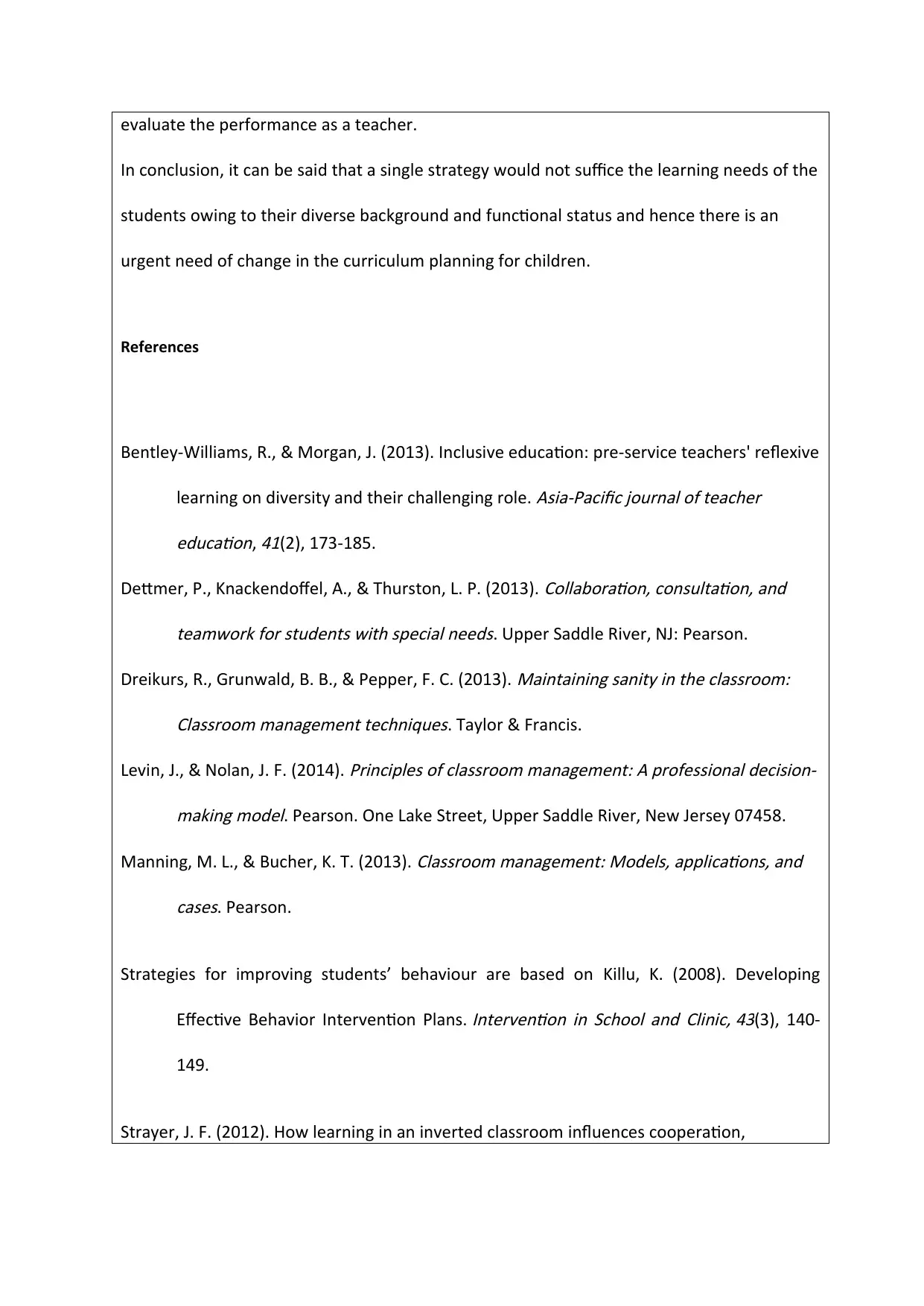
evaluate the performance as a teacher.
In conclusion, it can be said that a single strategy would not suffice the learning needs of the
students owing to their diverse background and functional status and hence there is an
urgent need of change in the curriculum planning for children.
References
Bentley-Williams, R., & Morgan, J. (2013). Inclusive education: pre-service teachers' reflexive
learning on diversity and their challenging role.
Asia-Pacific journal of teacher
education,
41(2), 173-185.
Dettmer, P., Knackendoffel, A., & Thurston, L. P. (2013).
Collaboration, consultation, and
teamwork for students with special needs. Upper Saddle River, NJ: Pearson.
Dreikurs, R., Grunwald, B. B., & Pepper, F. C. (2013).
Maintaining sanity in the classroom:
Classroom management techniques. Taylor & Francis.
Levin, J., & Nolan, J. F. (2014).
Principles of classroom management: A professional decision-
making model. Pearson. One Lake Street, Upper Saddle River, New Jersey 07458.
Manning, M. L., & Bucher, K. T. (2013).
Classroom management: Models, applications, and
cases. Pearson.
Strategies for improving students’ behaviour are based on Killu, K. (2008). Developing
Effective Behavior Intervention Plans.
Intervention in School and Clinic, 43(3), 140-
149.
Strayer, J. F. (2012). How learning in an inverted classroom influences cooperation,
In conclusion, it can be said that a single strategy would not suffice the learning needs of the
students owing to their diverse background and functional status and hence there is an
urgent need of change in the curriculum planning for children.
References
Bentley-Williams, R., & Morgan, J. (2013). Inclusive education: pre-service teachers' reflexive
learning on diversity and their challenging role.
Asia-Pacific journal of teacher
education,
41(2), 173-185.
Dettmer, P., Knackendoffel, A., & Thurston, L. P. (2013).
Collaboration, consultation, and
teamwork for students with special needs. Upper Saddle River, NJ: Pearson.
Dreikurs, R., Grunwald, B. B., & Pepper, F. C. (2013).
Maintaining sanity in the classroom:
Classroom management techniques. Taylor & Francis.
Levin, J., & Nolan, J. F. (2014).
Principles of classroom management: A professional decision-
making model. Pearson. One Lake Street, Upper Saddle River, New Jersey 07458.
Manning, M. L., & Bucher, K. T. (2013).
Classroom management: Models, applications, and
cases. Pearson.
Strategies for improving students’ behaviour are based on Killu, K. (2008). Developing
Effective Behavior Intervention Plans.
Intervention in School and Clinic, 43(3), 140-
149.
Strayer, J. F. (2012). How learning in an inverted classroom influences cooperation,

innovation and task orientation.
Learning environments research,
15(2), 171-193.
Learning environments research,
15(2), 171-193.
⊘ This is a preview!⊘
Do you want full access?
Subscribe today to unlock all pages.

Trusted by 1+ million students worldwide
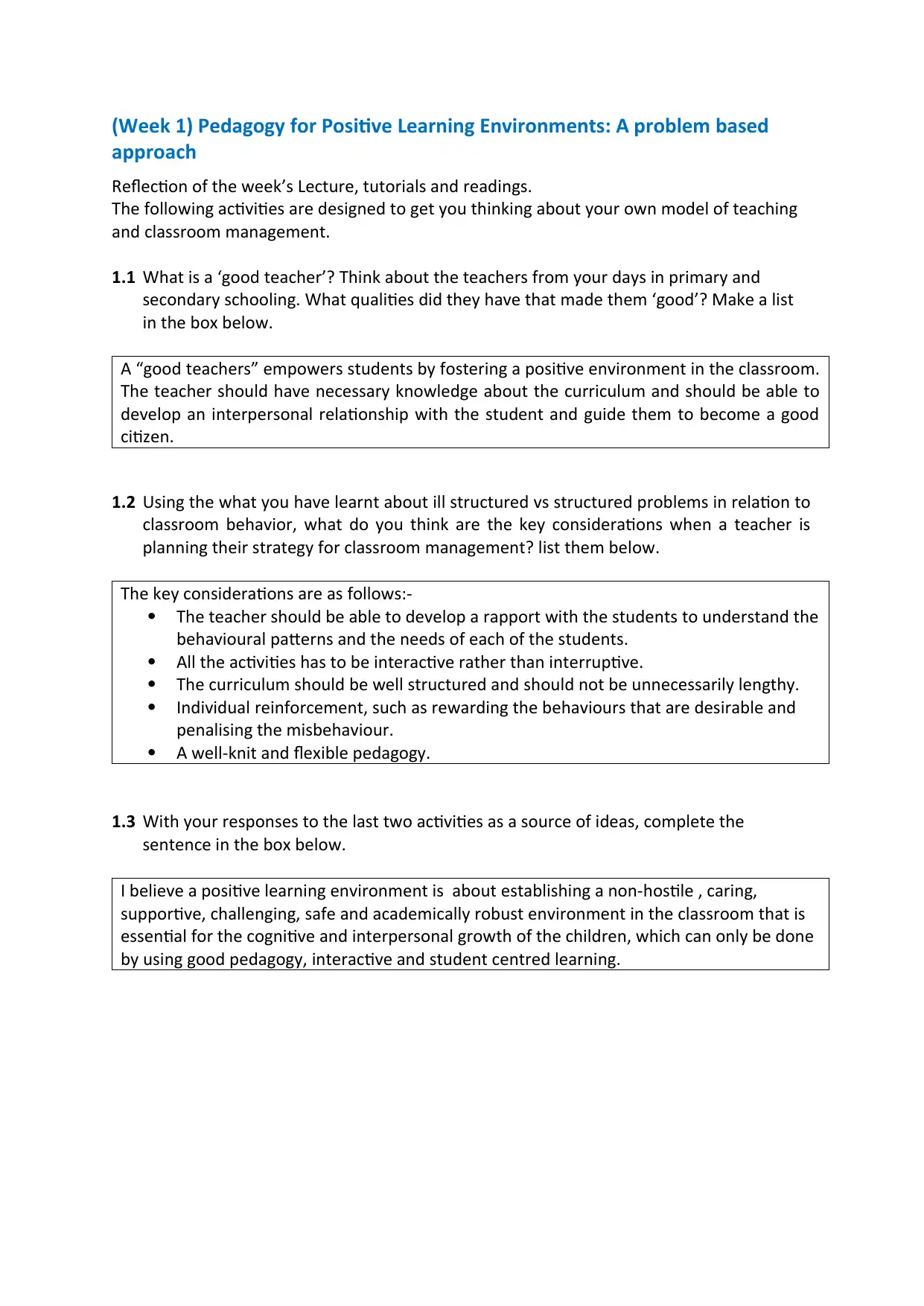
(Week 1) Pedagogy for Positive Learning Environments: A problem based
approach
Reflection of the week’s Lecture, tutorials and readings.
The following activities are designed to get you thinking about your own model of teaching
and classroom management.
1.1 What is a ‘good teacher’? Think about the teachers from your days in primary and
secondary schooling. What qualities did they have that made them ‘good’? Make a list
in the box below.
A “good teachers” empowers students by fostering a positive environment in the classroom.
The teacher should have necessary knowledge about the curriculum and should be able to
develop an interpersonal relationship with the student and guide them to become a good
citizen.
1.2 Using the what you have learnt about ill structured vs structured problems in relation to
classroom behavior, what do you think are the key considerations when a teacher is
planning their strategy for classroom management? list them below.
The key considerations are as follows:-
The teacher should be able to develop a rapport with the students to understand the
behavioural patterns and the needs of each of the students.
All the activities has to be interactive rather than interruptive.
The curriculum should be well structured and should not be unnecessarily lengthy.
Individual reinforcement, such as rewarding the behaviours that are desirable and
penalising the misbehaviour.
A well-knit and flexible pedagogy.
1.3 With your responses to the last two activities as a source of ideas, complete the
sentence in the box below.
I believe a positive learning environment is about establishing a non-hostile , caring,
supportive, challenging, safe and academically robust environment in the classroom that is
essential for the cognitive and interpersonal growth of the children, which can only be done
by using good pedagogy, interactive and student centred learning.
approach
Reflection of the week’s Lecture, tutorials and readings.
The following activities are designed to get you thinking about your own model of teaching
and classroom management.
1.1 What is a ‘good teacher’? Think about the teachers from your days in primary and
secondary schooling. What qualities did they have that made them ‘good’? Make a list
in the box below.
A “good teachers” empowers students by fostering a positive environment in the classroom.
The teacher should have necessary knowledge about the curriculum and should be able to
develop an interpersonal relationship with the student and guide them to become a good
citizen.
1.2 Using the what you have learnt about ill structured vs structured problems in relation to
classroom behavior, what do you think are the key considerations when a teacher is
planning their strategy for classroom management? list them below.
The key considerations are as follows:-
The teacher should be able to develop a rapport with the students to understand the
behavioural patterns and the needs of each of the students.
All the activities has to be interactive rather than interruptive.
The curriculum should be well structured and should not be unnecessarily lengthy.
Individual reinforcement, such as rewarding the behaviours that are desirable and
penalising the misbehaviour.
A well-knit and flexible pedagogy.
1.3 With your responses to the last two activities as a source of ideas, complete the
sentence in the box below.
I believe a positive learning environment is about establishing a non-hostile , caring,
supportive, challenging, safe and academically robust environment in the classroom that is
essential for the cognitive and interpersonal growth of the children, which can only be done
by using good pedagogy, interactive and student centred learning.
Paraphrase This Document
Need a fresh take? Get an instant paraphrase of this document with our AI Paraphraser

(Week 2) Review of classroom management theories
This week you have been introduced to some theories of behaviour/classroom
management. Your readings (Ch 8 & 9 of the text and De Jong in tutorials) introduced you to
different views on why young people misbehave and particularly what to do about it. Some
of these might have caused you to react in some way, either negatively or positively. Of the
ones you developed a positive feeling about, was there a particular theory that stood out?
Was there a theory or approach that you felt might fit your view of how children should be
treated and how teaching happens? Think about this before responding to the activities.
2.1 In the box below, list the theories that you think are ‘not for you’ under the heading
‘Not me’, and the theories that you think are more favourable under the heading ‘More
like me’.
Not me More like me
Ecological systems theory Goal centered theory
Humanistic approach
2.2 Now take a closer look at the theories you placed in the ‘More like me’ column. Read
the suggested readings provided in this chapter and the online companion. Get to know
the theories more intimately. Use this new knowledge, specifically the key philosophies
behind the theories (or theory), to develop your own statement of belief about the sort
of places classrooms should be. Complete the following sentence and perhaps add
another to accompany it.
I believe classrooms should be places where students will be able to get the appropriate
education without getting strictly controlled. All their queries should be properly addressed
that would help them to develop comprehensively.
This week you have been introduced to some theories of behaviour/classroom
management. Your readings (Ch 8 & 9 of the text and De Jong in tutorials) introduced you to
different views on why young people misbehave and particularly what to do about it. Some
of these might have caused you to react in some way, either negatively or positively. Of the
ones you developed a positive feeling about, was there a particular theory that stood out?
Was there a theory or approach that you felt might fit your view of how children should be
treated and how teaching happens? Think about this before responding to the activities.
2.1 In the box below, list the theories that you think are ‘not for you’ under the heading
‘Not me’, and the theories that you think are more favourable under the heading ‘More
like me’.
Not me More like me
Ecological systems theory Goal centered theory
Humanistic approach
2.2 Now take a closer look at the theories you placed in the ‘More like me’ column. Read
the suggested readings provided in this chapter and the online companion. Get to know
the theories more intimately. Use this new knowledge, specifically the key philosophies
behind the theories (or theory), to develop your own statement of belief about the sort
of places classrooms should be. Complete the following sentence and perhaps add
another to accompany it.
I believe classrooms should be places where students will be able to get the appropriate
education without getting strictly controlled. All their queries should be properly addressed
that would help them to develop comprehensively.
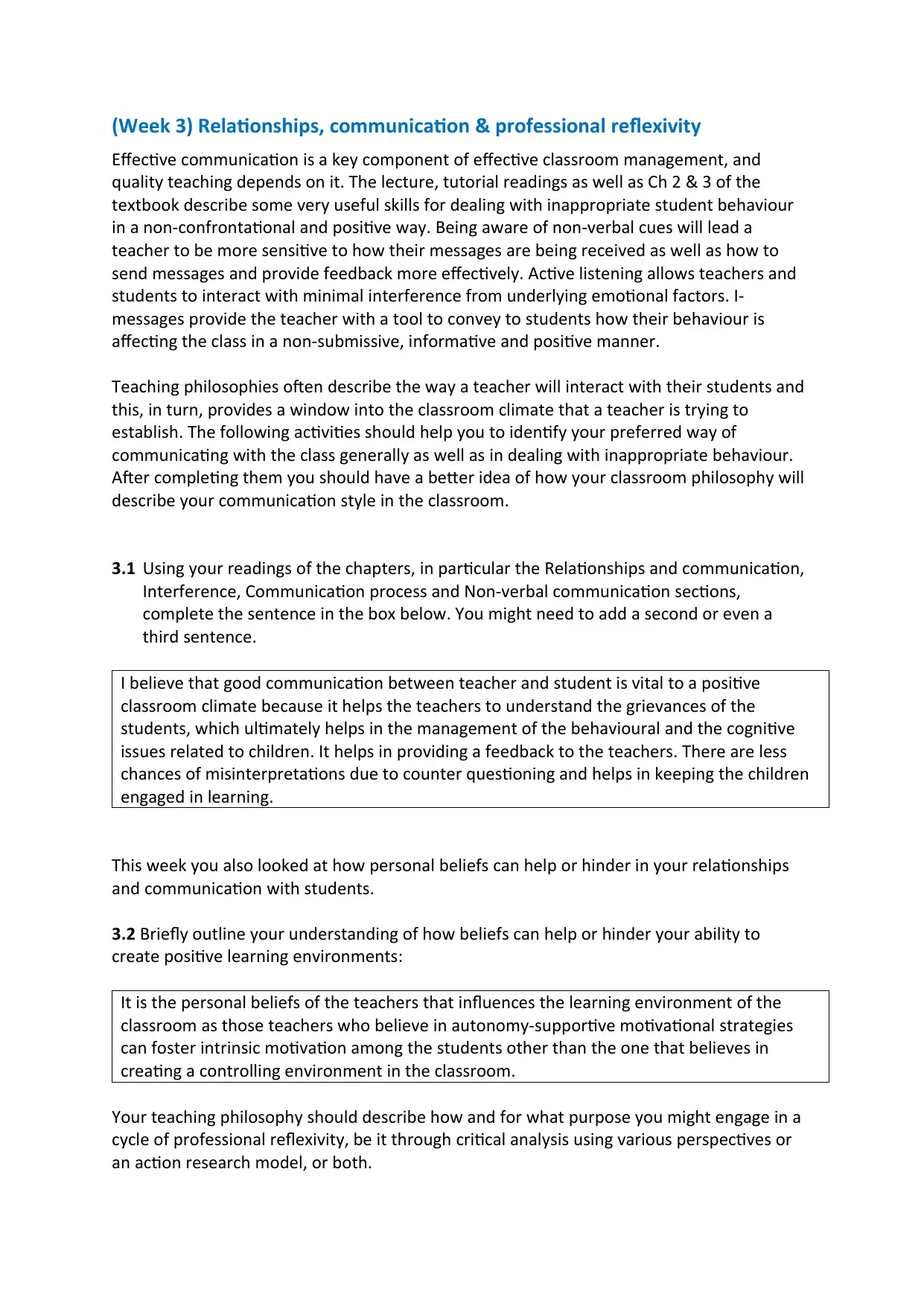
(Week 3) Relationships, communication & professional reflexivity
Effective communication is a key component of effective classroom management, and
quality teaching depends on it. The lecture, tutorial readings as well as Ch 2 & 3 of the
textbook describe some very useful skills for dealing with inappropriate student behaviour
in a non-confrontational and positive way. Being aware of non-verbal cues will lead a
teacher to be more sensitive to how their messages are being received as well as how to
send messages and provide feedback more effectively. Active listening allows teachers and
students to interact with minimal interference from underlying emotional factors. I-
messages provide the teacher with a tool to convey to students how their behaviour is
affecting the class in a non-submissive, informative and positive manner.
Teaching philosophies often describe the way a teacher will interact with their students and
this, in turn, provides a window into the classroom climate that a teacher is trying to
establish. The following activities should help you to identify your preferred way of
communicating with the class generally as well as in dealing with inappropriate behaviour.
After completing them you should have a better idea of how your classroom philosophy will
describe your communication style in the classroom.
3.1 Using your readings of the chapters, in particular the Relationships and communication,
Interference, Communication process and Non-verbal communication sections,
complete the sentence in the box below. You might need to add a second or even a
third sentence.
I believe that good communication between teacher and student is vital to a positive
classroom climate because it helps the teachers to understand the grievances of the
students, which ultimately helps in the management of the behavioural and the cognitive
issues related to children. It helps in providing a feedback to the teachers. There are less
chances of misinterpretations due to counter questioning and helps in keeping the children
engaged in learning.
This week you also looked at how personal beliefs can help or hinder in your relationships
and communication with students.
3.2 Briefly outline your understanding of how beliefs can help or hinder your ability to
create positive learning environments:
It is the personal beliefs of the teachers that influences the learning environment of the
classroom as those teachers who believe in autonomy-supportive motivational strategies
can foster intrinsic motivation among the students other than the one that believes in
creating a controlling environment in the classroom.
Your teaching philosophy should describe how and for what purpose you might engage in a
cycle of professional reflexivity, be it through critical analysis using various perspectives or
an action research model, or both.
Effective communication is a key component of effective classroom management, and
quality teaching depends on it. The lecture, tutorial readings as well as Ch 2 & 3 of the
textbook describe some very useful skills for dealing with inappropriate student behaviour
in a non-confrontational and positive way. Being aware of non-verbal cues will lead a
teacher to be more sensitive to how their messages are being received as well as how to
send messages and provide feedback more effectively. Active listening allows teachers and
students to interact with minimal interference from underlying emotional factors. I-
messages provide the teacher with a tool to convey to students how their behaviour is
affecting the class in a non-submissive, informative and positive manner.
Teaching philosophies often describe the way a teacher will interact with their students and
this, in turn, provides a window into the classroom climate that a teacher is trying to
establish. The following activities should help you to identify your preferred way of
communicating with the class generally as well as in dealing with inappropriate behaviour.
After completing them you should have a better idea of how your classroom philosophy will
describe your communication style in the classroom.
3.1 Using your readings of the chapters, in particular the Relationships and communication,
Interference, Communication process and Non-verbal communication sections,
complete the sentence in the box below. You might need to add a second or even a
third sentence.
I believe that good communication between teacher and student is vital to a positive
classroom climate because it helps the teachers to understand the grievances of the
students, which ultimately helps in the management of the behavioural and the cognitive
issues related to children. It helps in providing a feedback to the teachers. There are less
chances of misinterpretations due to counter questioning and helps in keeping the children
engaged in learning.
This week you also looked at how personal beliefs can help or hinder in your relationships
and communication with students.
3.2 Briefly outline your understanding of how beliefs can help or hinder your ability to
create positive learning environments:
It is the personal beliefs of the teachers that influences the learning environment of the
classroom as those teachers who believe in autonomy-supportive motivational strategies
can foster intrinsic motivation among the students other than the one that believes in
creating a controlling environment in the classroom.
Your teaching philosophy should describe how and for what purpose you might engage in a
cycle of professional reflexivity, be it through critical analysis using various perspectives or
an action research model, or both.
⊘ This is a preview!⊘
Do you want full access?
Subscribe today to unlock all pages.

Trusted by 1+ million students worldwide
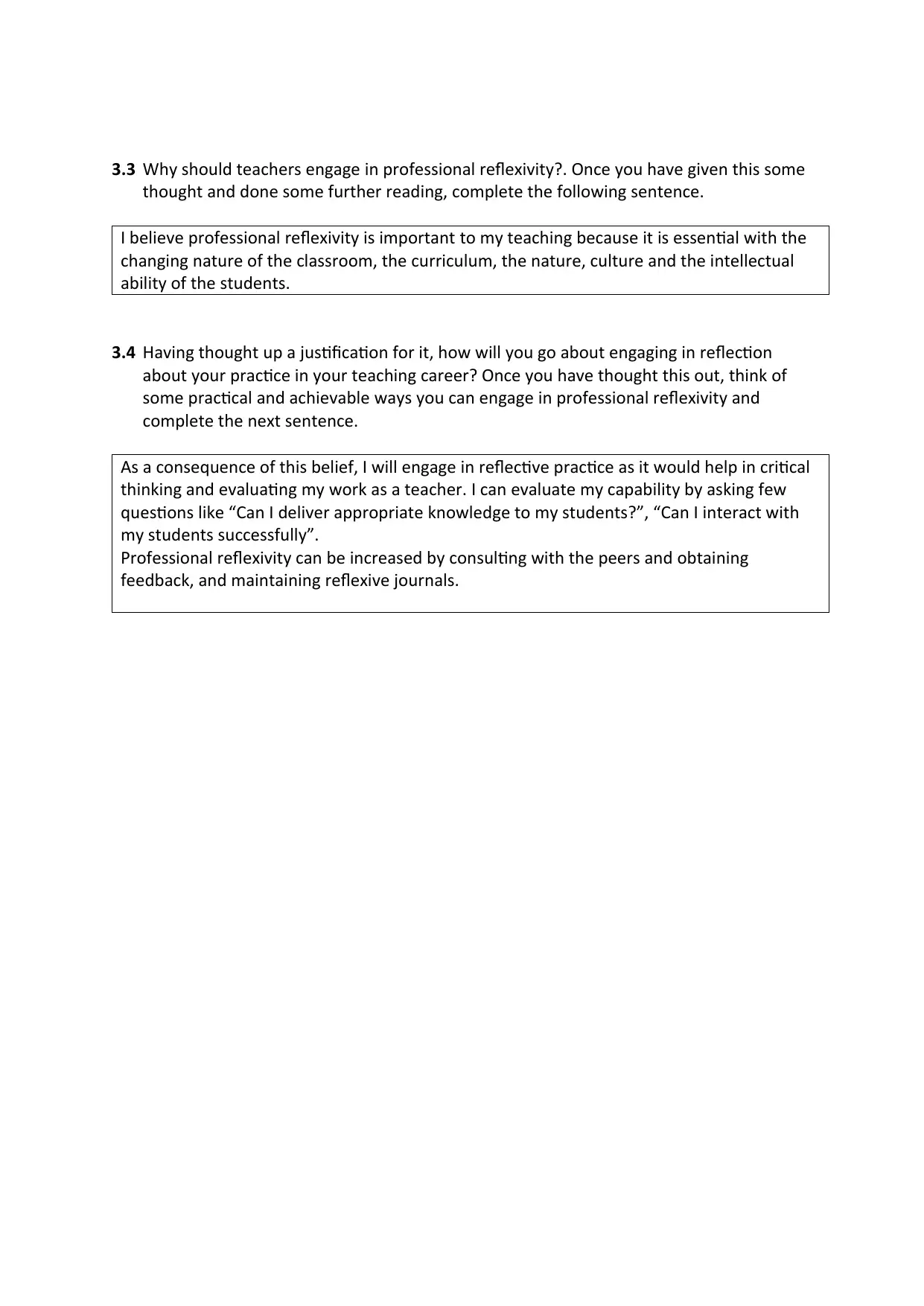
3.3 Why should teachers engage in professional reflexivity?. Once you have given this some
thought and done some further reading, complete the following sentence.
I believe professional reflexivity is important to my teaching because it is essential with the
changing nature of the classroom, the curriculum, the nature, culture and the intellectual
ability of the students.
3.4 Having thought up a justification for it, how will you go about engaging in reflection
about your practice in your teaching career? Once you have thought this out, think of
some practical and achievable ways you can engage in professional reflexivity and
complete the next sentence.
As a consequence of this belief, I will engage in reflective practice as it would help in critical
thinking and evaluating my work as a teacher. I can evaluate my capability by asking few
questions like “Can I deliver appropriate knowledge to my students?”, “Can I interact with
my students successfully”.
Professional reflexivity can be increased by consulting with the peers and obtaining
feedback, and maintaining reflexive journals.
thought and done some further reading, complete the following sentence.
I believe professional reflexivity is important to my teaching because it is essential with the
changing nature of the classroom, the curriculum, the nature, culture and the intellectual
ability of the students.
3.4 Having thought up a justification for it, how will you go about engaging in reflection
about your practice in your teaching career? Once you have thought this out, think of
some practical and achievable ways you can engage in professional reflexivity and
complete the next sentence.
As a consequence of this belief, I will engage in reflective practice as it would help in critical
thinking and evaluating my work as a teacher. I can evaluate my capability by asking few
questions like “Can I deliver appropriate knowledge to my students?”, “Can I interact with
my students successfully”.
Professional reflexivity can be increased by consulting with the peers and obtaining
feedback, and maintaining reflexive journals.
Paraphrase This Document
Need a fresh take? Get an instant paraphrase of this document with our AI Paraphraser
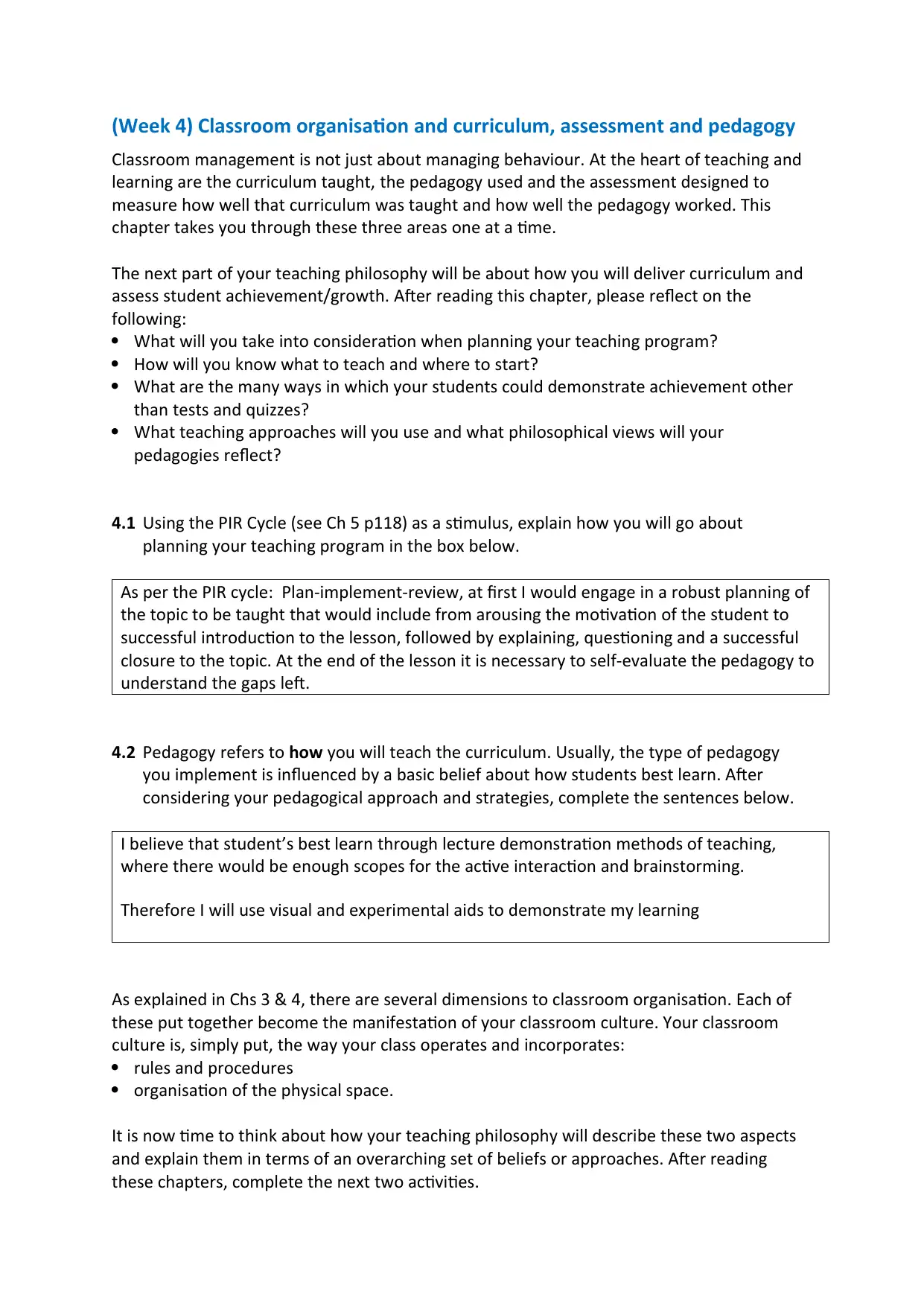
(Week 4) Classroom organisation and curriculum, assessment and pedagogy
Classroom management is not just about managing behaviour. At the heart of teaching and
learning are the curriculum taught, the pedagogy used and the assessment designed to
measure how well that curriculum was taught and how well the pedagogy worked. This
chapter takes you through these three areas one at a time.
The next part of your teaching philosophy will be about how you will deliver curriculum and
assess student achievement/growth. After reading this chapter, please reflect on the
following:
What will you take into consideration when planning your teaching program?
How will you know what to teach and where to start?
What are the many ways in which your students could demonstrate achievement other
than tests and quizzes?
What teaching approaches will you use and what philosophical views will your
pedagogies reflect?
4.1 Using the PIR Cycle (see Ch 5 p118) as a stimulus, explain how you will go about
planning your teaching program in the box below.
As per the PIR cycle: Plan-implement-review, at first I would engage in a robust planning of
the topic to be taught that would include from arousing the motivation of the student to
successful introduction to the lesson, followed by explaining, questioning and a successful
closure to the topic. At the end of the lesson it is necessary to self-evaluate the pedagogy to
understand the gaps left.
4.2 Pedagogy refers to how you will teach the curriculum. Usually, the type of pedagogy
you implement is influenced by a basic belief about how students best learn. After
considering your pedagogical approach and strategies, complete the sentences below.
I believe that student’s best learn through lecture demonstration methods of teaching,
where there would be enough scopes for the active interaction and brainstorming.
Therefore I will use visual and experimental aids to demonstrate my learning
As explained in Chs 3 & 4, there are several dimensions to classroom organisation. Each of
these put together become the manifestation of your classroom culture. Your classroom
culture is, simply put, the way your class operates and incorporates:
rules and procedures
organisation of the physical space.
It is now time to think about how your teaching philosophy will describe these two aspects
and explain them in terms of an overarching set of beliefs or approaches. After reading
these chapters, complete the next two activities.
Classroom management is not just about managing behaviour. At the heart of teaching and
learning are the curriculum taught, the pedagogy used and the assessment designed to
measure how well that curriculum was taught and how well the pedagogy worked. This
chapter takes you through these three areas one at a time.
The next part of your teaching philosophy will be about how you will deliver curriculum and
assess student achievement/growth. After reading this chapter, please reflect on the
following:
What will you take into consideration when planning your teaching program?
How will you know what to teach and where to start?
What are the many ways in which your students could demonstrate achievement other
than tests and quizzes?
What teaching approaches will you use and what philosophical views will your
pedagogies reflect?
4.1 Using the PIR Cycle (see Ch 5 p118) as a stimulus, explain how you will go about
planning your teaching program in the box below.
As per the PIR cycle: Plan-implement-review, at first I would engage in a robust planning of
the topic to be taught that would include from arousing the motivation of the student to
successful introduction to the lesson, followed by explaining, questioning and a successful
closure to the topic. At the end of the lesson it is necessary to self-evaluate the pedagogy to
understand the gaps left.
4.2 Pedagogy refers to how you will teach the curriculum. Usually, the type of pedagogy
you implement is influenced by a basic belief about how students best learn. After
considering your pedagogical approach and strategies, complete the sentences below.
I believe that student’s best learn through lecture demonstration methods of teaching,
where there would be enough scopes for the active interaction and brainstorming.
Therefore I will use visual and experimental aids to demonstrate my learning
As explained in Chs 3 & 4, there are several dimensions to classroom organisation. Each of
these put together become the manifestation of your classroom culture. Your classroom
culture is, simply put, the way your class operates and incorporates:
rules and procedures
organisation of the physical space.
It is now time to think about how your teaching philosophy will describe these two aspects
and explain them in terms of an overarching set of beliefs or approaches. After reading
these chapters, complete the next two activities.

4.3 What values do you hold as important to establishing an orderly, productive and
positive classroom? Answer this question below, then list the key rules/expectations
you think flow naturally from those values and which you want to stress in your class.
Complete the section by explaining how rules and consequences will be established in
your classroom.
An orderly and productive classroom means that there would be a conducing environment,
where the student will have the rights to express concerns and display his/her creativities or
innovations and the teacher would cater to the needs of the students and cultivate a caring
and a respectful culture.
Rules can be established in classrooms by promoting self-regulation, catering to the needs
of the student and facilitating problem solving.
positive classroom? Answer this question below, then list the key rules/expectations
you think flow naturally from those values and which you want to stress in your class.
Complete the section by explaining how rules and consequences will be established in
your classroom.
An orderly and productive classroom means that there would be a conducing environment,
where the student will have the rights to express concerns and display his/her creativities or
innovations and the teacher would cater to the needs of the students and cultivate a caring
and a respectful culture.
Rules can be established in classrooms by promoting self-regulation, catering to the needs
of the student and facilitating problem solving.
⊘ This is a preview!⊘
Do you want full access?
Subscribe today to unlock all pages.

Trusted by 1+ million students worldwide
1 out of 16
Related Documents
Your All-in-One AI-Powered Toolkit for Academic Success.
+13062052269
info@desklib.com
Available 24*7 on WhatsApp / Email
![[object Object]](/_next/static/media/star-bottom.7253800d.svg)
Unlock your academic potential
Copyright © 2020–2025 A2Z Services. All Rights Reserved. Developed and managed by ZUCOL.





